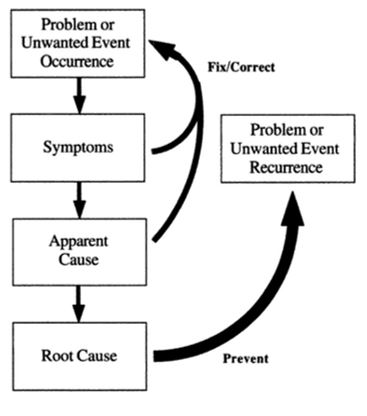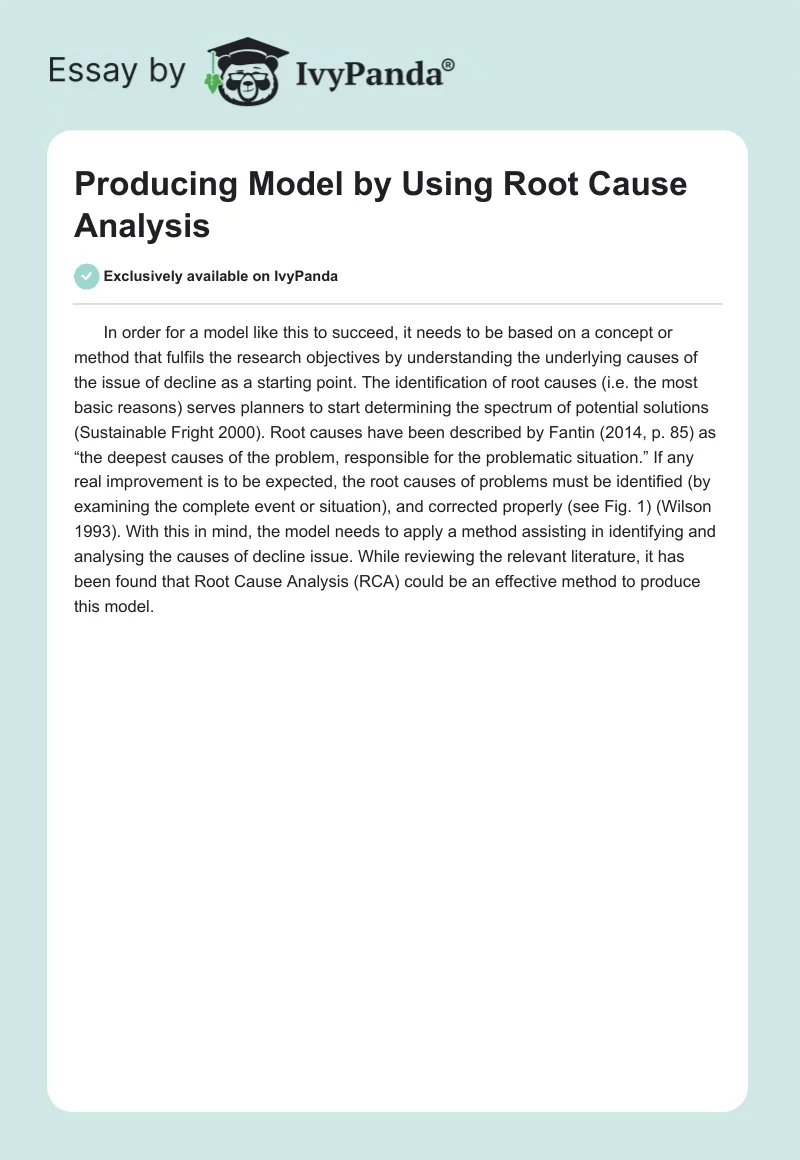In order for a model like this to succeed, it needs to be based on a concept or method that fulfils the research objectives by understanding the underlying causes of the issue of decline as a starting point. The identification of root causes (i.e. the most basic reasons) serves planners to start determining the spectrum of potential solutions (Sustainable Fright 2000). Root causes have been described by Fantin (2014, p. 85) as “the deepest causes of the problem, responsible for the problematic situation.” If any real improvement is to be expected, the root causes of problems must be identified (by examining the complete event or situation), and corrected properly (see Fig. 1) (Wilson 1993). With this in mind, the model needs to apply a method assisting in identifying and analysing the causes of decline issue. While reviewing the relevant literature, it has been found that Root Cause Analysis (RCA) could be an effective method to produce this model.

RCA was initially used in high-reliability industries in order to identify the underlying factors of variation in performance (Lee et al. 2011, p. 305). It combines elements from engineering, psychology, and the ‘human factors’ tradition (Reason 1990; Vincent, Taylor-Adams & Stanhope 1998). As an improvement technique and a governance tool, this approach is based on the assumption that it is possible to prevent the reoccurrence of adverse events and the necessary lessons drawn by determining the underlying causes (Nicolini et al. 2011, p. 217). Instead of continuing to deal with symptoms, this procedure seeks to describe causal chains as well as to identify and correct the root cause factors (i.e. the most rudimentary cause) of the problem occurred (Flott 2011; Huston 2014; Reason 1990). RCA “can be a powerful tool to help determine current obstacles to improvement, as well as identify those particular areas in which operation/process improvements might produce the greatest benefit” (Wilson 1993, p. 3). Therefore, RCA is not only a problem-solving method; it can also be a proactive analysis tackling issues that are likely to occur due to a preventive action. According to Cerniglia-Lowensen (2015), the effective RCA covers three types of causes: physical causes (tangible material), human causes and organisational causes (policy or procedure). Performing effective RCA has several advantages that are pointed out by Wilson (1993, p. 11) as follows:
- “Ensuring objective problem solving;
- Facilitating development of a comprehensive set of solutions;
- Predicting other problems;
- Identifying, assembling, and integrating contributory circumstances;
- Focusing on preventing recurrence, as well as providing immediate corrective action;
- Identifying improvement opportunities”.
As a process, RCA can be conducted through the following steps (Cerniglia-Lowensen 2015). The first step is the identification of the issue that should be investigated. The next step is the understanding of that issue that can be reached by collecting the required data. In this stage, collecting data through consulting key stakeholders has been recommended “to develop a solid idea” about the potential causes of the issue (CoE-SUFS 2016). The third step is the identification of the possible causal factors. By analysing contributing factors, the identification of root causes would be possible (QAPI 2005). Identifying root causes can provide a better understanding of what happened, how it happened and why it happened. This identification makes it possible to determine the cost of the root cause remove (Flott 2011). The fourth step focuses on the recommendations and changes that should be implemented to eliminate the root causes. It covers both corrective and preventive actions. Stakeholders can also participate in the determination of corrective and/or preventive actions (remedial actions) needed to prevent reoccurrence (Nicolini et al. 2011). The next step is to confirm the solution. In order to determine the implemented actions that resulted in positive change, there is a need to develop measures for each action as part of RCA process (Lee et al. 2011, p. 306). According to Wilson (1993, p. 3), there is a need for qualitative and/or quantitative measures to ensure that needed improvements/changes meet and maintain the target objectives. Therefore, several recommended indicators/criteria should be considered to do this measurement.
In summary, RCA approach can serve this research to measure/find the corrective action(s) through understanding the issue itself, analysing several causes to find out the root ones and other contributed factors. Then this classification can be used to determine the corrective action. It can also assist planners to determine whether this action can be implemented in short-/long-term or not. Therefore, RCA method seems to be useful for the fulfilment of research objectives.


